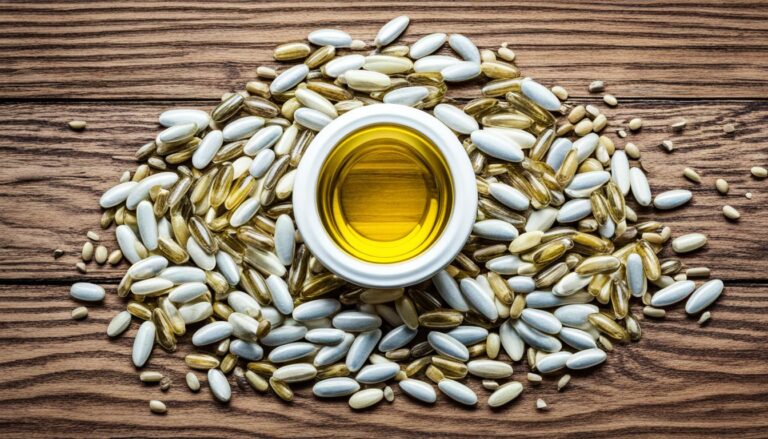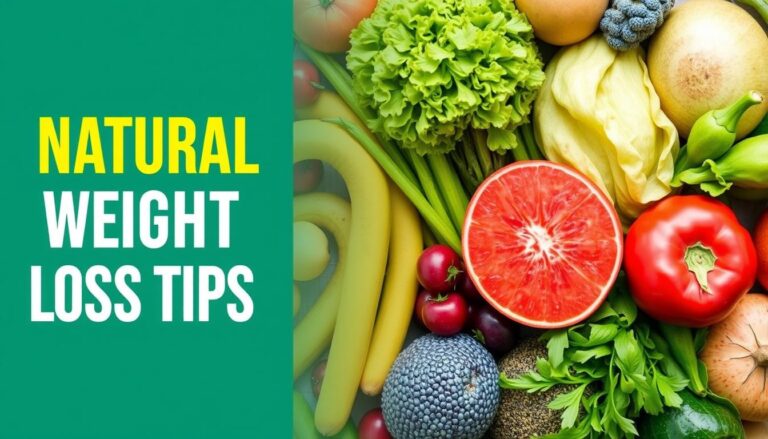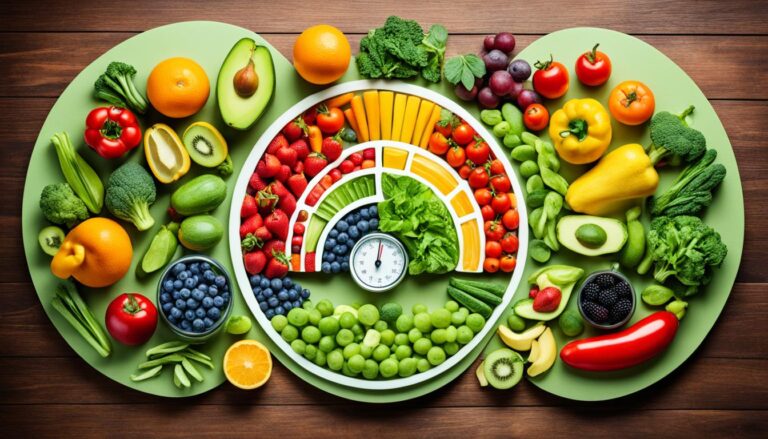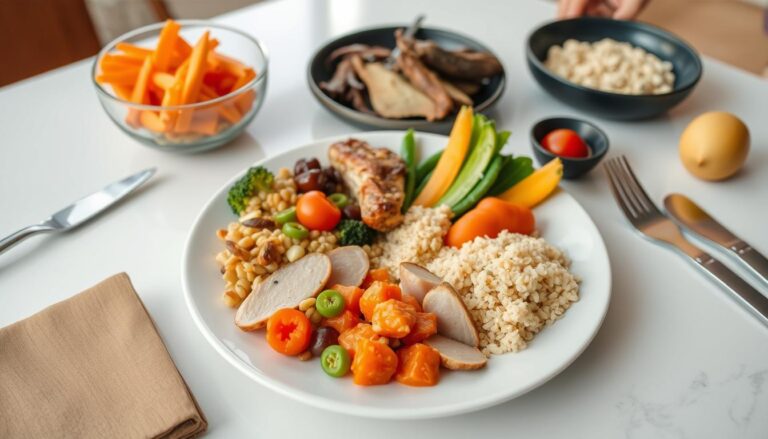What if everything you’ve been told about weight loss is missing a crucial piece? Traditional advice often focuses on strict diets and tracking every calorie.
But modern science reveals a smarter approach one that works with your body not against it.
Research shows hormones sleep and food quality play bigger roles than simple calorie math. For example prioritizing protein can reduce daily intake by 441 calories naturally. Similarly poor sleep spikes obesity risk by 55%. The key? Sustainable habits over short-term restrictions.
This article explores 16 evidence-backed strategies to reshape your relationship with food. From optimizing meals to balancing hormones, you’ll learn how to achieve lasting results no calculator required.
Key Takeaways
- Hormones and metabolism matter more than calorie counts
- High protein meals can cut hundreds of daily calories
- Sleep quality directly impacts fat storage
- Habit changes outperform restrictive diets long-term
- Food quality influences hunger signals and portion control
Why Calorie Counting Isn’t the Only Path to Weight Loss
Not all calories are created equal here’s why it matters. The eat less move more mantra ignores how your body processes different foods. Research shows hormones digestion speed and even gut bacteria play bigger roles than simple math.
The Flaws in the Eat Less, Move More Mentality
Calories in/out CICO works in theory but fails in practice. Why? Three reasons:
- Thermic effect: Protein burns 25–30% of its calories during digestion while carbs burn just 6–8%.
- Hormonal responses: Processed food spikes insulin storing fat faster than whole foods.
- Hunger signals: A 2022 study found 30% protein intake reduces daily calories by 441 without effort.
100 calories of broccoli stabilizes blood sugar 100 calories of candy triggers cravings within hours.
How Hormones and Food Quality Impact Weight
Leptin satiety hormone and ghrelin hunger hormone dictate your energy balance. Processed foods disrupt both, leading to overeating. Meanwhile fiber rich meals produce butyrate a compound that reduces inflammation and fat storage.
Cortisol adds another layer. Chronic stress elevates this hormone, directing fat to your midsection. A 2021 UCLA study linked high cortisol levels to 11% more belly fat over five years.
Key takeaway: A diet focused on food quality and hormonal balance outperforms calorie restriction for long-term weight loss.
How to Lose Weight Without Counting Calories 16 Science Backed Strategies
Ditching calorie tracking doesn’t mean abandoning results. Research backed ways to lose weight focus on hormonal balance metabolism, and behavior. Here’s a preview of 16 strategies that deliver lasting change.
- Preserve muscle: Lean mass burns 3x more calories than fat at rest. Strength training prevents metabolic slowdown.
- Boost NEAT: Non exercise activity like walking accounts for 15% of daily energy expenditure. Stand more, fidget often.
- Time meals wisely: Eating protein-rich foods every 3–4 hours stabilizes blood sugar and reduces cravings.
- Use smaller plates: A Cornell study found this cuts portions by 22% without conscious effort.
An 8-week study compared egg and bagel breakfasts. The egg group ate 18% fewer calories at lunch proof that food quality matters.
Stress and sleep play hidden roles. High cortisol spikes hunger while poor sleep disrupts leptin. Simple fixes like hydration and mindful eating also curb overeating.
Sustainable weight management hinges on habits not deprivation.
1. Swap Grain Breakfasts for Protein Packed Eggs
Eggs outperform grains in curbing appetite and boosting metabolism. A study in the International Journal of Obesity found participants eating eggs for breakfast lost 2 lbs in 8 weeks 65% more than the bagel group’s 1.3 lbs. The secret? Egg yolks trigger cholecystokinin, a hormone that delays hunger signals.
The Science Behind Egg’s Satiety Power
Eggs provide leucine and B12 nutrients that stabilize blood sugar. Compared to a 245-calorie bagel, one 78-calorie egg offers:
| Nutrient | Egg 1 large | Bagel 1 medium |
|---|---|---|
| Protein | 6g | 9g |
| Fiber | 0g | 2g |
| Fat | 5g | 1g |
| Satiety Score | High | Low |
Egg eaters consumed 18% fewer calories at lunch proof that morning protein reduces overall intake.
5-Minute Egg Based Breakfasts
- Spinach Feta Scramble: Whisk 2 eggs with ¼ cup spinach and 1 tbsp feta. Cook in olive oil 3 mins.
- Microwave Egg Muffins: Beat eggs with diced veggies, pour into muffin tin and microwave 90 seconds.
- Vegan Option: Tofu scramble with turmeric and nutritional yeast mimics eggs texture.
These meals leverage eggs nutrients to keep you full for hours. No counting required just results.
2. Trick Your Brain with Smaller Plates
Your eyes can deceive you when it comes to food portions here’s how to use it to your advantage. The Delboeuf optical illusion makes equal portions appear larger on small plates and smaller on big ones. This simple switch reduces intake by 22%, per a Cornell study comparing 9 and 12 plates.
The Psychology of Portion Perception
Color contrast enhances the effect. A white plate makes pasta look larger, while a dark plate exaggerates light-colored foods like rice. For calorie-dense foods like nuts use bowls no wider than 4 inches to prevent overeating.
Cultural norms play a role too. Average dinner plates grew from 8.5 in the 1950s to 12 today a way to unintentionally increase portion sizes. Reset your baseline with these visual cues:
| Food Type | Hand Measurement | Plate Zone |
|---|---|---|
| Protein | Palm-sized | 1/4 plate |
| Carbs | Fist-sized | 1/4 plate |
| Veggies | Unlimited | 1/2 plate |
Overweight individuals underestimate portions by 20% proof that brain biases need countermeasures.
Apply the half-plate rule to meals: Fill 50% with non-starchy vegetables first. This crowds out extra calories while boosting fiber. Pair with protein to stabilize hunger for hours.
3. Prioritize Protein at Every Meal
Protein isn’t just for bodybuilders it’s your secret weapon for effortless satiety. Research shows it boosts metabolism by 15–30% and reduces hunger more effectively than carbs or fats. Start with 30g per meal to trigger optimal benefits.
The Science Behind Protein and Satiety
Your body burns 20–30% of protein calories during digestion thermic effect. Compare that to just 5–10% for carbs. This means a 300-calorie chicken breast nets ~210 usable calories after digestion.
Leucine, an amino acid in protein, also sparks muscle synthesis. A 2023 study found high protein diets preserve 95% of muscle during fat loss key for maintaining metabolism.
Participants eating 30g protein at breakfast consumed 18% fewer calories at lunch.
Best Lean Protein Sources
Incorporate these foods into your meals:
- Animal based: Chicken breast 31g/100g salmon 25g/100g Greek yogurt 10g/100g.
- Plant based: Tempeh 19g/100g lentils 9g/100g quinoa 4g/100g. Combine rice + beans for complete amino acids.
Avoid processed protein bars with added sugars. Instead try a spinach-feta omelet or edamame salad for lasting energy.
4. Load Up on Low Calorie Density Foods
Eating more while losing fat sounds impossible until you discover low calorie density foods. These options pack volume and nutrients without excess calories helping you feel full naturally. Research shows soup eaters lose 50% more weight by leveraging this principle.
The Science of Volume Eating
High water and high-fiber foods slow digestion and stretch stomach receptors. Compare 100 calories of spinach 10 cups to olive oil 1 tablespoon. The spinach’s bulk triggers satiety signals while the oil’s density bypasses them.
Participants eating broth-based soups consumed 20% fewer calories at subsequent meals.
Top Low Calorie Density Choices
Incorporate these vegetables into meals:
- Zucchini: 17 calories per cup spiralize for noodles.
- Mushrooms: 22 calories per cup sauté with garlic.
- Shirataki noodles: 10 calories per serving try stir fry with tofu.
| Food | Calories per Cup | Fiber g |
|---|---|---|
| Spinach | 7 | 0.7 |
| Cauliflower | 25 | 2 |
| Strawberries | 49 | 3 |
Cooled potatoes develop resistant starch reducing digestible calories by 10–12%. Pair with a pre-meal salad 500g daily = 17% more loss in 12 weeks. Avoid creamy dressings they negate the benefits.
5. Cut Carbs to Curb Cravings Naturally
Reducing carbs can reset your body’s hunger signals and break the cycle of cravings. Studies show low carb diets lead to greater fat loss participants shed 18.7 lbs compared to 8.6 lbs on standard plans. The secret lies in how your body processes glucose and stores energy.
The Science Behind Carb Reduction
Insulin your fat storage hormone, spikes with carb intake. High levels block fat burning and increase hunger. A 2022 study found diets with 50g daily carbs reduced ghrelin hunger hormone by 22%.
Ketosis, reached after 3 days of very low carb intake, shifts your body to burn fat for fuel. This state also increases GLP-1, a hormone that promotes fullness. Athletes may benefit from cyclical carb intake higher carbs on training days.
| Food | Smart Swap | Net Carbs |
|---|---|---|
| White rice | Cauliflower rice | 3g vs 45g |
| Pasta | Zucchini noodles | 4g vs 43g |
| Bread | Lettuce wraps | 1g vs 12g |
Low carb eaters reported 31% fewer cravings and spontaneous calorie reduction.
Practical Implementation
Start with a moderate approach 100-150g net carbs daily. Focus on fiber rich vegetables and berries. For those going below 50g:
- Increase electrolytes to avoid keto flu symptoms
- Prioritize avocados nuts, and olive oil for energy
- Monitor protein intake to maintain muscle mass
Blood sugar management improves within days. Pair this strategy with adequate protein and healthy fats for balanced nutrition without deprivation.
6. Optimize Sleep to Balance Hunger Hormones
Poor sleep doesn’t just leave you tired it rewires your hunger signals. Research links fewer than 6 hours nightly to a 55% higher obesity risk. The culprit? Disrupted hormones that govern appetite and fat storage.

The Link Between Poor Sleep and Weight Gain
Four hours of sleep slashes leptin satiety hormone by 15.5%. Simultaneously, ghrelin hunger hormone spikes driving cravings for sugary high calorie foods. A 2021 study found sleep deprived participants ate 385 extra calories daily enough to gain 1 lb weekly.
Cortisol exacerbates the problem. Elevated levels from poor sleep direct fat to the midsection. UCLA researchers noted 11% more belly fat in chronic short sleepers over five years.
8.5-hour sleepers lost 55% more fat than 5.5-hour sleepers, despite identical diets.
Actionable Sleep Fixes
- Blue light cutoff: Avoid screens 2 hours before bed. Use amber bulbs or blue light blockers.
- Magnesium glycinate: 400mg nightly improves sleep depth and reduces cortisol.
- Bedroom optimization: 18°C 65°F room temperature blackout curtains, and white noise.
REM sleep boosts insulin sensitivity, aiding metabolism. Alcohol disrupts this phase limit to 1 drink, 3+ hours before bed. Prioritize consistency: A fixed wake time regulates circadian rhythms better than weekend catch up sleep.
7. Practice Mindful Eating to Avoid Overeating
Your phone might be sabotaging your meals without you realizing it. Distracted eatingL Like scrolling or watching TV can lead to 288 extra calories per meal according to a American Journal of Clinical Nutrition study. The fix? Redirect your attention to the plate.
The Science of Distracted Consumption
Multitasking during meals delays satiety signals. Try the 20 chews per bite technique to slow pacing. A hunger scale 1–10 helps too stop eating at 6 or 7 not when stuffed.
Phone stacking during dinners reduces intake by 15% participants focus on conversation not screens.
Break the Scroll Snack Cycle
Dopamine drives both social media and snack cravings. Use the 5-4-3-2-1 grounding method:
- 5 deep breaths before eating
- 4 sensory observations color smell texture taste
- 3 mindful bites without distractions
Apps like Eat Right Now teach bite awareness. For portion control, try chopsticks they naturally limit bite size.
8. Choose Whole Foods Over Processed Options
The path to better health starts with what’s on your plate quality matters more than quantity. Whole foods like vegetables, lean proteins and nuts deliver essential nutrients without hidden additives. Research shows an 80/20 ratio whole vs. processed optimizes energy and reduces cravings.
Nutrient Density vs. Empty Calories
Compare 100 calories of broccoli to chips. The broccoli offers fiber, vitamin C and antioxidants, while the chips provide little beyond refined carbs and salt. Processed foods are engineered for hyper palatability tricks like sugar-fat combos override natural fullness signals.
| Nutrient | Broccoli 100kcal | Chips 100kcal |
|---|---|---|
| Fiber | 9g | 1g |
| Vitamin C | 168% DV | 0% DV |
| Added Sugar | 0g | 2g |
Whole-food diets increase non exercise activity thermogenesis NEAT by 13% aiding passive calorie burn.
Smart Swaps and Shopping Rules
Follow the 5 ingredient rule: If a label lists more, it’s likely overly processed. Beware healthy traps like granola bars many pack more sugar than candy. For snacks try these cleaner options:
- RXBARs: Dates egg whites nuts no added sugar
- Seaweed snacks: Low calorie rich in iodine
- Dark chocolate 85%+: Antioxidants without sugar spikes
Prioritize colorful produce high ORAC values antioxidant scores fight inflammation. A meal matrix of protein + veggies + smart carbs e.g., quinoa balances energy and satiety.
9. Ditch Liquid Calories for Water or Tea
Liquid calories slip past your body’s natural defenses making them a hidden hurdle in weight management. Unlike solid foods beverages don’t trigger the same fullness signals leading to effortless overconsumption.
The Problem With Sugary Drinks
A 20oz soda packs 240 calories but won’t make you eat less later. Fructose, the sugar in sweetened drinks bypasses leptin signaling. This can lead to consuming 17% more calories throughout the day.
Research shows liquid energy gets stored as fat faster than food calories. The liver processes beverages differently increasing triglyceride production by 32% compared to solid carbs.
| Beverage | Calories | Satiety Impact |
|---|---|---|
| Cola 20oz | 240 | None |
| Orange Juice 8oz | 112 | Low |
| Sparkling Water | 0 | Moderate |
500ml of water before meals reduces calorie intake by 13% equivalent to 1lb monthly weight loss.
Smart Hydration Strategies
Thirst often masquerades as hunger. Try these refreshing alternatives:
- Cucumber-Mint Infusion: 8 cups water + ½ sliced cucumber + 10 mint leaves steep 2 hours
- Berry Hibiscus Tea: Cold brew hibiscus tea with frozen raspberries
- Spiced Pu-erh: Traditional Chinese tea that may reduce fat absorption
Beware diet drink traps artificial sweeteners may disrupt gut bacteria. For coffee lovers switching from a daily latte to black coffee saves $1,200 annually and 73,000 calories.
10. Track Progress Beyond the Scale
The scale tells just one part of your health transformation story. Your body undergoes dozens of measurable changes that numbers can’t capture. A 2023 Journal of Obesity study found participants focusing solely on weight missed 73% of their actual improvements.
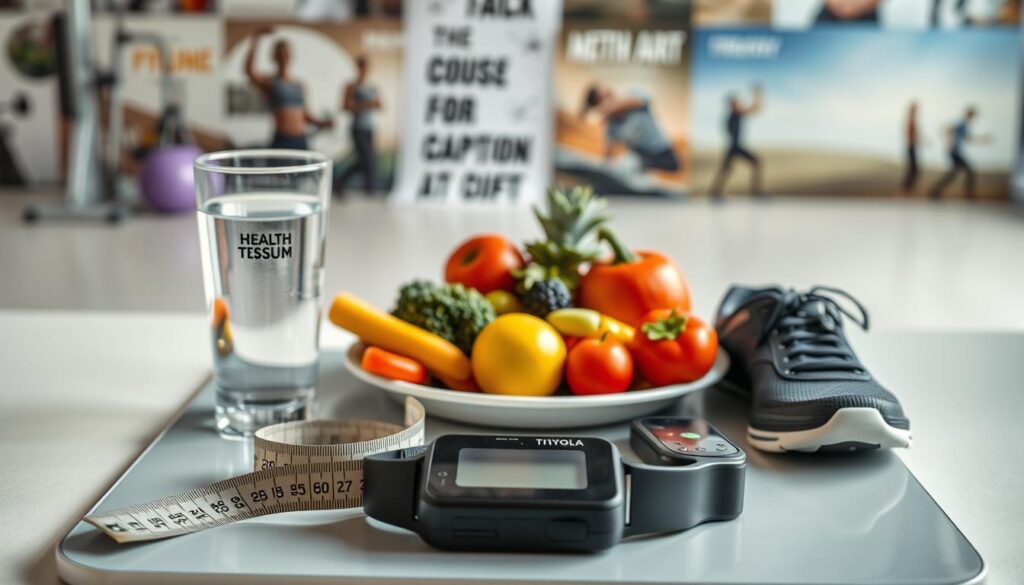
Read more: What’s Your Weight Loss Routine?
25 Meaningful Non Scale Victories
Celebrate these subtle signs of progress:
- Clothing fit: Rings slide off jeans button easily
- Energy: Stairs feel easier afternoon slumps vanish
- Strength: Carrying groceries without strain
- Sleep: Waking refreshed before the alarm
- Skin: Reduced puffiness clearer complexion
1-inch waist reduction lowers cardiovascular disease risk by 8% regardless of weight change.
Advanced Measurement Techniques
Move beyond basic scales with these precise tools:
| Method | What It Measures | Accuracy |
|---|---|---|
| DEXA Scan | Bone density, lean mass, fat % | ±1.5% |
| Smart Scale | Weight estimated body fat | ±5-8% |
| Waist Tape | Visceral fat risk men | Exact |
Progress photos every 4 weeks reveal subtle changes. Client Sarah dropped 2 dress sizes despite stable scale readings proof that measurements matter more than pounds.
Warning: Daily weighing often backfires. Research shows it increases stress hormones by 17%. Instead, track habits hydration steps for sustainable change.
11. Build Muscle to Boost Metabolism
Your muscles do more than just look good they’re metabolic powerhouses. Every pound of muscle burns 6 calories daily at rest, compared to just 2 calories for fat. Over time this difference creates a significant impact on your body’s energy use.
The Afterburn Effect of Strength Training
EPOC excess post-exercise oxygen consumption keeps your metabolism elevated for up to 38 hours after resistance exercise. This afterburn effect can torch an extra 150-200 calories per session. Compound movements yield the best results:
- Deadlifts: Engages 75% of your muscle mass
- Push-ups: Works chest shoulders and core simultaneously
- Squats: Activates the powerful glute and leg muscles
Optimal Training Frequency
A 3x weekly full-body routine maximizes results. Research shows this schedule:
| Frequency | Muscle Gain 12 weeks | Metabolic Boost |
|---|---|---|
| 3x/week | 2.4 lbs | 9% increase |
| 1x/week | 0.8 lbs | 3% increase |
Gaining 1lb of muscle burns 22,000 extra calories annually equivalent to 6lbs of fat loss.
Protein Timing Matters
Consume 20-40g protein within 2 hours post-workout. This window maximizes muscle protein synthesis. Whey protein absorbs fastest, while casein provides sustained release.
Avoid excessive cardio more than 3 hours weekly can trigger muscle loss. For home workouts, resistance bands offer comparable results to weights:
- Band squats: Place band above knees for glute activation
- Seated rows: Anchor band to a sturdy object
- Overhead presses: Step on band with feet shoulder width apart
Strength training reshapes your body composition permanently. Unlike restrictive diets, the metabolic benefits compound over time.
12. Move More Throughout the Day
Non-exercise movement could be your missing link for better metabolism. NEAT non exercise activity thermogenesis accounts for 15-50% of daily energy expenditure that’s up to 350 calories burned without formal workouts.
Harnessing Everyday Movement
Small changes create compounding benefits. A Mayo Clinic study found fidgeters burn 350 more calories daily than still sitters. This equals 36 pounds yearly at the same food intake.
Standing desks increase NEAT by 54 calories/hour enough for 8 pounds annual loss with zero diet changes.
Try these effortless boosters:
- Pace during calls: 30-minute meetings become 100-calorie walks
- Park strategically: Adds 500+ steps daily
- Commercial break squats: 20 reps during ads burns 50 calories
Household Activities as Exercise
Chores count more than you think. Here’s what 30 minutes burns for a 155lb person:
| Activity | Calories | Equivalent To |
|---|---|---|
| Mopping floors | 153 | 15-minute jog |
| Gardening | 167 | 20 burpees |
| Carrying groceries | 130 | 1-mile walk |
Wearables like Oura Ring track NEAT automatically. Set hourly move reminders just 2 minutes of walking offsets sitting’s metabolic slowdown.
Warning: Don’t compensate with extra food. Studies show people overestimate workout burns by 300% and eat back the difference.
13. Manage Stress to Prevent Cortisol Spikes
Your stress response could be the hidden driver behind stubborn belly fat. When activated chronically, it triggers a cascade of hormonal changes that prioritize fat storage especially around your midsection.
The Biology of Stress-Induced Weight Gain
The HPA axis hypothalamus-pituitary-adrenal governs your stress reactions. Under pressure it floods your body with cortisol a hormone that:
- Increases visceral fat storage by 22% Journal of Clinical Endocrinology, 2022
- Triggers cravings for high calorie foods
- Slows metabolism by suppressing thyroid function
A 12-week yoga study demonstrated tangible results. Participants reduced waist circumference by 1.5 inches through cortisol management alone no diet changes.
5-Minute Stress Reset Techniques
Combat cortisol spikes with these science backed methods:
4-7-8 breathing lowers cortisol 37% faster than standard meditation.
- Breathwork: Inhale 4 sec hold 7 sec exhale 8 sec 3 cycles
- Adaptogens: Ashwagandha 500mg or rhodiola 200mg daily
- Micro laughter: 30 seconds of forced giggles reduces stress markers
| Activity | Cortisol Reduction | Time |
|---|---|---|
| Desk meditation | 26% | 5 mins |
| Nature walk | 31% | 15 mins |
| Hand massage | 19% | 3 mins |
What to Avoid
Chronic cardio 60+ mins daily can backfire by elevating cortisol long-term. Instead opt for:
- Strength training 3x weekly
- Walking meetings
- Tai chi for movement-based stress relief
For severe cases DHEA supplements 25-50mg may help rebalance hormones consult your doctor first. Remember: Stress management isn’t just about health it’s metabolic optimization.
14. Eat Regularly to Avoid Ravenous Hunger
Skipping meals backfires by triggering extreme hunger later in the day. When blood sugar drops too low, your body releases stress hormones that drive overeating. Consistent meal timing prevents this cycle.
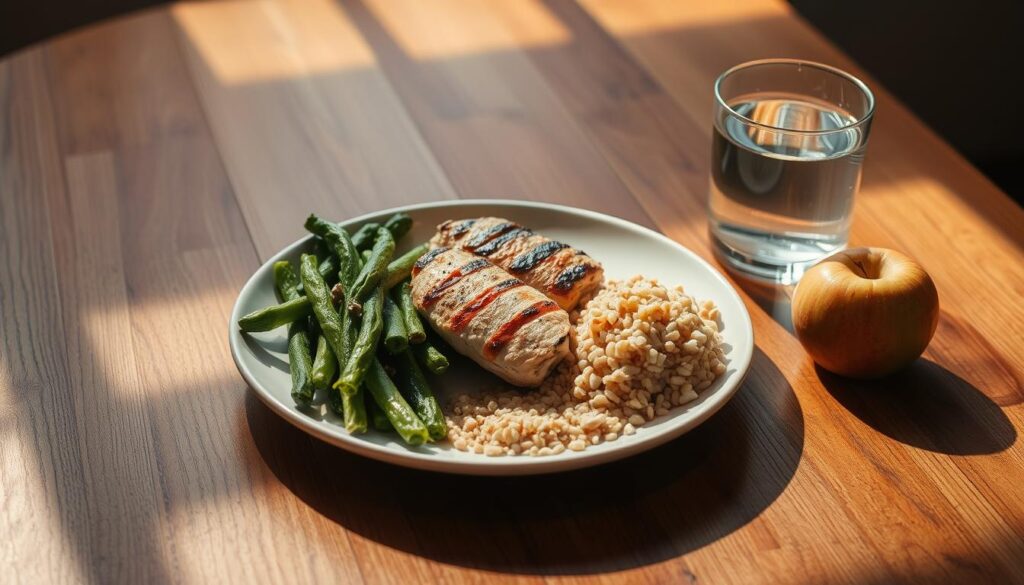
Read more: Benefits of adding high fat foods to meals
The Blood Sugar Rollercoaster
Hypoglycemia low blood sugar causes a 47% spike in ghrelin your hunger hormone. A 2023 Nutrition Journal study found meal skippers consumed 35% more calories at their next meals compared to regular eaters.
Follow this 300-400 calorie template every 3-4 hours:
- Protein: 20-30g eggs, Greek yogurt
- Fiber: 5g+ berries, leafy greens
- Healthy fats: 10g avocado, nuts
Smart Snacking Strategies
These balanced snack combos stabilize energy:
- Apple slices + 1 tbsp almond butter
- Cottage cheese + cucumber rounds
- Hard-boiled egg + cherry tomatoes
Regular eaters maintain 17% lower BMI than meal skippers, despite identical calorie intake.
| Time | Insulin Sensitivity | Ideal Meal Type |
|---|---|---|
| 7-9 AM | High | Protein + complex carbs |
| 12-2 PM | Moderate | Lean protein + veggies |
| 5-7 PM | Low | Light protein + fiber |
Prepare emergency snack packs like nuts + dark chocolate to avoid vending machine traps. Never save calories for later it leads to nighttime binges.
15. Cook More Meals at Home
Your kitchen holds the power to transform your eating habits without strict rules. Restaurant dishes often pack hidden calories and oversized portions the average dine out meal contains 1,128 calories, according to USDA data. Meanwhile, home-cooked meals offer control over ingredients and serving sizes.
The Restaurant Portion Trap
Chain restaurants design dishes for profit, not nutrition. Olive Garden’s lasagna delivers 1,220 calories nearly a full day’s worth for some. A homemade version with lean beef and whole wheat noodles cuts that by 40%.
Watch for these common pitfalls:
- Free bread baskets: 3 slices = 330 extra calories before the meal
- Cream-based sauces: Alfredo packs 500+ calories per cup
- Bottomless drinks: One soda refill adds 200+ empty calories
Home cooks consume 137 fewer calories daily while eating more vegetables and whole grains.
Smart Home Cooking Strategies
Recreate restaurant favorites with healthier twists:
| Restaurant Dish | Home Swap | Calories Saved |
|---|---|---|
| Cheesecake Factory Pasta | Zucchini noodles + marinara | 780 |
| Chili’s Baby Back Ribs | Air-fryer pork tenderloin | 420 |
| Starbucks Frappuccino | Cold brew + protein shake | 310 |
Meal prep containers with portion dividers simplify healthy eating. Look for these features:
- BPA-free materials glass or stainless steel
- 1-cup compartments for carbs, 2-cup for veggies
- Stackable design for freezer storage
Batch cooking saves time and prevents takeout temptations. Freeze these staples for quick meals:
- Quinoa or brown rice 3-month shelf life
- Marinated chicken breasts 6 months
- Vegetable soup bases 8 months
Beware health halo menu labels terms like organic or gluten free don’t guarantee low calories. Always check nutrition facts even at so called healthy chains.
16. Enjoy Treats Mindfully Without Guilt
Your brain rewards planned treats differently than impulsive ones. Neuroscience shows anticipation triggers 27% more dopamine when treats are scheduled versus spontaneous. This makes mindful indulgence a powerful tool for sustainable diet success.
The Science of Strategic Indulgence
A 2022 Appetite study found participants who planned desserts had 76% fewer binges. Why? Pre-commitment satisfies the pleasure center without guilt spirals. Try these research-backed approaches:
- Savoring ritual: Let dark chocolate melt slowly on your tongue for full flavor appreciation
- Single serving packs: 100-150 calorie portions like mini ice cream bars or 1oz cheese cubes
- Dopamine delay: Wait 10 minutes after craving onset intensity drops 40%
Planned treats activate prefrontal cortex control, while impulsive snacks trigger reward-system hijacking.
Implementing a Tiered Treat System
Categorize indulgences to balance enjoyment and progress:
| Tier | Frequency | Examples |
|---|---|---|
| Daily | 1-2x/day | Dark chocolate square, berries with whip |
| Weekly | 2-3x/week | Gelato scoop, homemade cookie |
| Monthly | 1x/month | Restaurant dessert split three ways |
When cravings strike, use the PAUSE method:
- Physically stop put down your phone
- Assess hunger rate 1-10
- Use distraction drink water take a walk
- Select mindfully choose from your tier plan
- Enjoy slowly 20-minute consumption
Avoid the last supper mentality deprivation often leads to rebound overeating. For guilt free alternatives try:
- Banana nice cream blended with cocoa powder
- Protein pudding Greek yogurt + peanut butter powder
- Roasted chickpeas with cinnamon for crunch cravings
Conclusion Sustainable Weight Loss Without Obsession
True transformation happens when health becomes a lifestyle, not a temporary fix. The 16 strategies shared here from protein prioritization to stress management work together to create lasting change.
Focus on one or two habits weekly. Track non scale wins like energy levels or clothing fit. This process reshapes your body and mindset over time.
Avoid perfectionism. Small sustainable steps outperform short term extremes. Start your 30-day challenge today journal progress to stay motivated.
Remember weight loss isn’t the only measure of success. Celebrate every victory along the way.
